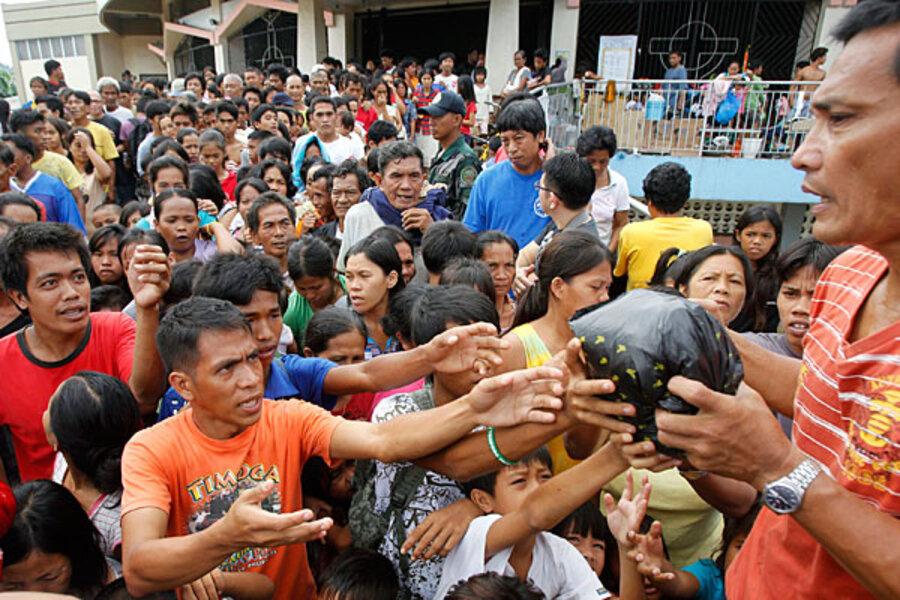Typhoon Sendong: Did illegal logging cause flash flooding in Philippines?
Loading...
| ILIGAN, Philippines
Philippine President Benigno Aquino ordered an investigation on Tuesday into flash floods and landslides that sent mud and logs crashing down on residents, killing about 1,000 people on a southern island.
The national disaster agency said 957 were killed and 49 missing on Mindanao after Typhoon Sendong (aka Typhoon Washi) triggered the slides. Most of the casualties were in the cities of Cagayan de Oro and Iligan and tens of thousands remain homeless, many sheltering in evacuation centres.
Aquino met officials in the two cities worst hit by the cascades that swept down mountainsides as residents of riverside and coastal villages slept in the early hours of Saturday.
IN PICTURES: Typhoons hammer the Philippines
"First priority is to relocate to areas that no longer pose a danger to them," Aquino told a meeting in Cagayan de Oro, issuing instructions to implement disaster mitigation programmes, including reforestation.
He later told a gathering at a school: "We have no desire to engage in finger-pointing or to assign blame at a time like this. Yet, we have an obligation to find out exactly what has happened."
Aquino said he had formed a task force to investigate the reasons behind the disaster and to determine whether a nationwide logging ban had been violated.
He declared a state of national disaster, a move intended to release greater funding, and ordered the speedy restoration of power and drinking water supplies in all affected villages.
"If we want this tragedy to be the last of its kind, we need to learn from our mistakes," he saidd."
NATIONAL CALAMITY
The disaster agency said more than 338,000 people in 13 provinces were affected by the disaster, with nearly 43,000 still in schools, churches and gymnasiums.
More than 10,000 houses were damaged by the typhoon and the flash floods, of which nearly a third were ruined. Many schools, roads and bridges were also badly damaged.
More than 15 million pesos ($340,000) worth of crops, mostly rice and corn, were damaged, but the Agriculture department said losses were minimal as the crops were in the early planting stage.
Aquino said the government can also access funds from multilateral financial institutions, including $3 million from the Asian Development Bank and about $500 million in low-interest loans from the World Bank.
Survivors said huge logs thundering down mountainsides crushed residents. Television footage showed many recovered bodies with arms or hands raised as if reaching out for help or clinging on to something.
Cagayan de Oro and Iligan were struggling to prevent disease from spreading in evacuation centres, with construction proceeding quickly of burial vaults and plots in public cemeteries to bury decomposing bodies.
Iligan has started burying truckloads of bodies, with some family members or residents of the same villages entombed in a single sepulchre. A Reuters photographer saw bodies lined up along the highway in Cagayan de Oro outside a small funeral home.
An official of the British-based Christian relief and development organisation World Vision said people were fighting for space at evacuation centres.
"It is really overcrowded, there is almost no space in between people," group official John Salva told ANC Television. "Diseases are starting to appear."
"It's really a struggle to manage those evacuation centres, there's a shortage of water and a shortage of food," he said.
The state-run Mines and Geosciences Bureau (MGB) said it had warned authorities in the area last year about the need to relocate families living along riverbanks that swelled after one month's worth of rainfall fell over the weekend.
"This tragedy that happened in Cagayan de Oro ... will be repeated in the future. And therefore, there needs to be appropriate preparation to prevent fatalities," Leo Jasareno, acting director of the MGB said in a television interview. ($=44 Philippine pesos) (
Additional reporting by Manny Mogato in Manila; Writing by Rosemarie Francisco; Editing by Ron Popeski)





